The next-gen MacBook Pro with Retina Display Review
by Anand Lal Shimpi on June 23, 2012 4:14 AM EST- Posted in
- Mac
- Apple
- MacBook Pro
- Laptops
- Notebooks
All Flash Storage
As expected, the next-gen MacBook Pro ditches mechanical storage in favor of a MacBook Air style NAND + SSD controller on a custom PCB. Apple refers to this solution as all-flash storage.
Apple’s distinction between Solid State Drives (SSDs) and all-flash storage boils down to what form the storage comes in. If it’s a standard form factor device in a chassis, it’s a solid state drive. If it’s just NAND + controller on a PCB? Then it’s all-flash storage. I suspect it’s a nicer way of saying proprietary SSD but either way they are technically the same thing, just in different forms.
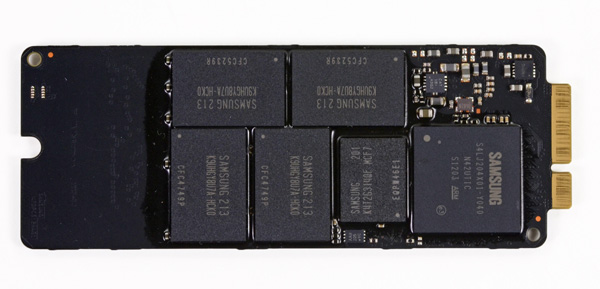
The Samsung PM830 based rMBP NAND flash storage card, image courtesy iFixit
My Retina MacBook Pro was the upgraded model with a 512GB SSD, featuring Samsung’s PM830 controller. This is the same controller as in the Samsung SSD 830, which I’ve long felt was the best pair for Mac users who wanted an SSD upgrade. I’m not sure if other Retina MBPs may come with Toshiba’s SandForce based drive instead. I have one of these drives in house for a review but that’ll have to wait until next week.
Although both the Samsung and Toshiba/SandForce controllers support full disk encryption, neither hardware based encryption is supported by OS X’s FileVault 2. When OS X encrypts your boot volume not all areas are encrypted (such as the recovery partition). While I know SandForce allegedly offers multiple encryption levels across a volume I’ve never seen either controller claim support for partially unencrypted volumes. In this case it looks like for Apple to take advantage of SSD controller based encryption it would need more flexible encryption support on the controller level. If I were an SSD controller vendor I’d be paying close attention to this requirement.
Both the Samsung and Toshiba controllers support 6Gbps SATA - as a result performance is significantly better compared to previous Apple branded SSDs. I borrowed a friend’s 2010 MacBook Pro which happened to have a Toshiba based SSD installed and ran it through our standard Iometer four-corners test suite. This was a well used drive and thus the performance is even worse than last year's MacBook Airs. The improvement in performance is astounding:
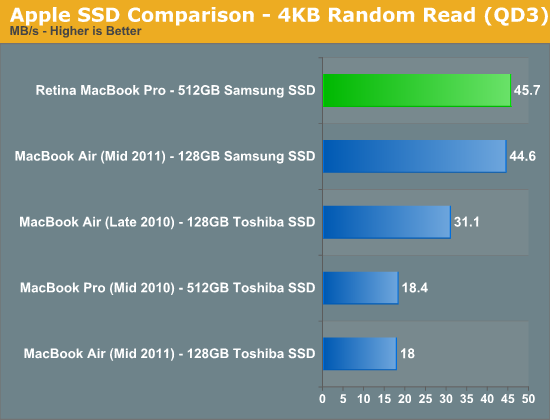
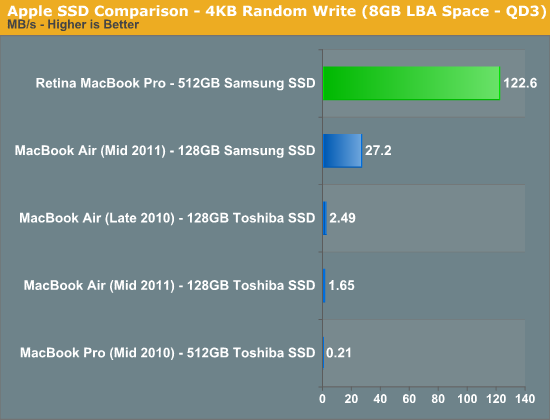
The move to 6Gbps SATA is often associated with a huge bump in sequential transfer rates, but in this case Apple enjoys a significant increase in random speeds as well. Note that some of this improvement is going to be due to the fully populated configuration of the PM830 in the Retina MacBook Pro's SSD, but that shouldn't downplay the significance of the move to Samsung's latest controller. The previous generation controller used last year just wasn't very good, and the Toshiba alternative was even worse. This year, Apple finally has a good solid state story to tell.
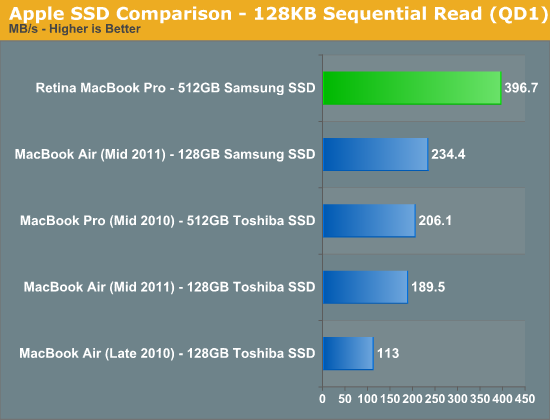
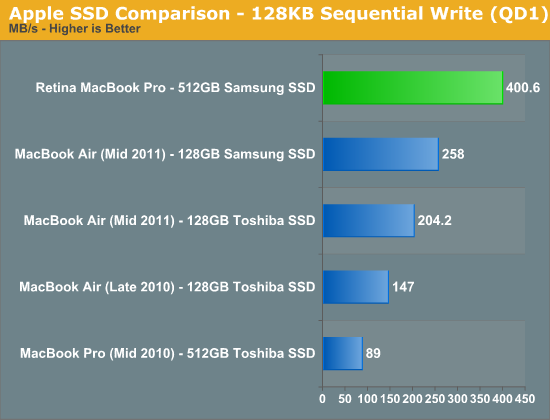
How much of this are you going to be able to actually tell in day to day use of the system? The sequential transfer rates are most tangible when you are writing to or reading large files like movies to your drive. Obviously you need a source that's fast enough to hit these speeds. Although USB 3.0 can come close you're unlikely to have a USB 3.0 SSD that's as fast as the internal drive. Moving large files between your internal SSD and Promise's Pegasus R4/R6 is where you'll really appreciate this performance.
The random access improvements are likely overkill for most normal uses. Things like program launches, compiling, web browsing, and any other normal application IO will depend on a mixture of random and sequential IO. The key is to have good enough random IO performance to avoid becoming a bottleneck. I can safely say that the numbers we see here are more than enough.
While previous Apple SSDs were nice only from a convenience standpoint, at least the Samsung option in the Retina MacBook Pro is what I’d recommend even if Apple didn’t bundle it with the machine.










471 Comments
View All Comments
vision33r - Sunday, June 24, 2012 - link
When a PC laptop goes on sale, the listed price is never the actual purchase price.A $1000 Dell usually end up getting sold for $800 or less after coupons and Dell runs sales all the time. Same goes for HP.
Apple almost never do a sale until the model is outdated, the only discount is the education one.
It's a certain that all PC laptop makers have to cut corners to make a profit, competition is fierce. Most buyers are more price sensitive these days then specs.
duploxxx - Monday, June 25, 2012 - link
Many manufacturers allow options in there designs towards more cutting edge technology...I have a full HD display in a 15"since 2008, same for my SSD.... just a matter of cutting cost for low profile. This differentiate with apple who already put these in the baseline... call bleding edge wathever you want but I am sure my Laptop cost probably a few 100$ less with eluminated keyb, optimus etc.... but it hasbn't got the shiny apple logo :)
Johnmcl7 - Saturday, June 23, 2012 - link
Sony have been offering 13.1 1920x1080 screens for a few years which admittedly isn't nearly as high as the new Macbook screen but given Sony have been frequently criticised for offering such a pointlessly high resolution it's little surprise they haven't developed it further.When Apple do it however they get praised for their innovation and bringing the market forward when in reality they're a while behind other companies who are genuinely innovative and getting the technology out there.
John
Super56K - Saturday, June 23, 2012 - link
I'm not sure you understand. It's rendered at double the resolution, but presented at the same size as 1440x900 or 1900x1200 on a 15" screen. You gain clarity rather than real estate.What other notebooks out there can do that?
ananduser - Saturday, June 23, 2012 - link
Lol...you just described DPI scaling. The retina mb just offers ready made presets. To achieve the same effect on the Z simply change the DPI scaling within the native resolution.KoolAidMan1 - Saturday, June 23, 2012 - link
Scaling in Windows doesn't work the same, nor is it targeted towards such specific resolutions. Anand talks about this himself in the review.Hopefully Windows 8 outside of the Metro UI addresses this.
OCedHrt - Sunday, June 24, 2012 - link
That's because Windows only goes up to 1.5 instead of 2. But at 1920x1080, 1.5 gives you 1280 x 720. Do you really want to go that small?ananduser - Sunday, June 24, 2012 - link
OMG...it's been said 10 times already in the comments. Windows goes all the way up to 200%. Anand does not know Windows setting well enough.ananduser - Sunday, June 24, 2012 - link
That't the idea, scaling should *NOT* be dependent on specific resolutions. It should be agnostic. That's what Windows does because it's supposed to power the world's computers, macs included.dagamer34 - Sunday, June 24, 2012 - link
Windows 8 addresses this by providing an easy way to serve up high resolution assets for the OS to use depending on the DPI of the machine. It takes all of the guesswork out of the developers hands with no extra code needed.